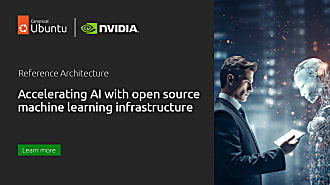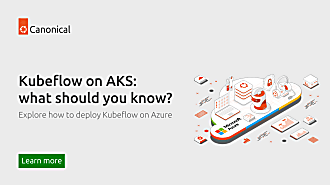Carmine Rimi
on 20 May 2019
Kubeflow at KubeCon Europe 2019 in Barcelona

Kubeflow, the Kubernetes native application for AI and Machine Learning, continues to accelerate feature additions and community growth. The community has released two new versions since the last Kubecon – 0.4 in January and 0.5 in April – and is currently working on the 0.6 release, to be released in July. The key features in each release are briefly discussed below.
Kubeflow at Kubecon
For those attending KubeCon + CloudNativeCon Europe 2019 in Barcelona, you can learn more about Kubeflow and how to apply it to your business in the following sessions:
TUESDAY, May 21
| 14:00 | Kubernetes the New Research Platform – Lindsey Tulloch, Brock University & Bob Killen, University of Michigan |
| 14:00 | Tutorial: Introduction to Kubeflow Pipelines – Michelle Casbon, Dan Sanche, Dan Anghel, & Michal Zylinski, Google |
| 15:55 | KubeFlow BoF (Birds of a Feather) – David Aronchick, Microsoft & Yaron Haviv, Iguazio |
WEDNESDAY, May 22
| 11:55 | Towards Kubeflow 1.0, Bringing a Cloud Native Platform For ML to Kubernetes – David Aronchick, Microsoft & Jeremy Lewi, Google |
| 14:00 | Building Cross-Cloud ML Pipelines with Kubeflow with Spark & Tensorflow – Holden Karau, Google & Trevor Grant, IBM |
| 14:50 | Managing Machine Learning in Production with Kubeflow and DevOps – David Aronchick, Microsoft |
THURSDAY, May 23
| 11:55 | A Tale of Two Worlds: Canary-Testing for Both ML Models and Microservices – Jörg Schad, ArangoDB & Vincent Lesierse, Vamp.io |
| 14:00 | Moving People and Products with Machine Learning on Kubeflow – Jeremy Lewi, Google & Willem Pienaar, GO-JEK |
| 14:50 | Economics and Best Practices of Running AI/ML Workloads on Kubernetes – Maulin Patel, Google & Yaron Haviv, Iguazio |
Come by the Canonical booth to learn how to get started with Kubeflow quickly and easily – on Ubuntu with Microk8s, and on Windows or macOS with Multipass and Microk8s.
What’s in Kubeflow 0.5?
- This is a summary of some of the key features:
- UI Improvements – new Central Dashboard and a new sidebar navigation
- JupyterHub Improvements – launch multiple notebooks, attach volume
- Fairing Python Library – build, train, and deploy models from notebooks or IDE
- Katib (hyperparameter) Improvements – more generic, updated CRD, better status
- KFCTL binary (configure and platform deploy). (https://deploy.kubeflow.cloud/)
- Pipelines Persistence (upgrade or reinstall)
- 150+ closed issues and 250+ merged PRs
You can learn more about the 0.5 release from the Kubeflow blog on 0.5.
What’s in Kubeflow 0.4?
- An updated JupyterHub UI that makes it easy to spawn notebooks with Persistent Volume Claims (PVCs).
- An alpha release of fairing, a python library that simplifies the build and train process for data scientists – they can start training jobs directly from a notebook or IDE.
- An initial release of a Custom Resource Definition (CRD) for managing Jupyter notebooks. You can use kubectl to create notebook containers.
- Kubeflow Pipelines for orchestrating ML workflows, which speeds the process of productizing models by reusing pipelines with different datasets or updated data.
- Katib support for TFJob, which makes it easier to tune models and compare performance with different hyper-parameters.
- Beta versions of the TFJob and PyTorch operators, which enable data scientists to program their training jobs against a more stable API and to more easily switch between training frameworks.
You can learn more about the 0.4 release from the Kubeflow blog on 0.4.
Learn more about Kubeflow
There is a wealth of information at kubeflow.org, this includes docs, blogs, and examples. In addition, you can go to ubuntu.com/ai/install to get started quickly.



